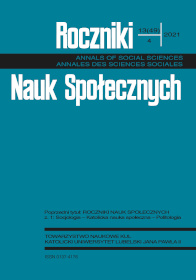Amerykańsko-chińska rywalizacja w kosmosie – wybrane aspekty strategiczne i polityczne
Abstrakt
Niniejszy artykuł opisuje trzy ściśle powiązane aspekty kosmicznej rywalizacji między Stanami Zjednoczonymi i Chinami tle ich ogólnych stosunków. Pierwszy omawiany aspekt dotyczy kwestii strategicznych związanych z siłami zbrojnymi jako instrumentem globalnego wpływu. Drugi obejmuje proces sekurytyzacji chińskich postępów w rozwoju zastosowań kosmicznych w Stanach Zjednoczonych. Trzeci odnosi się do konkurencji o międzynarodowy prestiż, która jest jednym z najważniejszych czynników relacji chińsko-amerykańskich.
Bibliografia
Alic J. A. (2021), The U.S. Politico–Military–Industrial Complex, [in:] Oxford Research Encyclopaedia, https://oxfordre.com/politics/view/10.1093/acrefore/9780190228637.001.0001/acrefore-9780190228637-e-1870 [Accessed: 15.11.2021].
Biddle S., Oelrich I. (2016), Future Warfare in the Western Pacific: Chinese Antiaccess/Area Denial, U.S. AirSea Battle, and Command of the Commons in East Asia, International Security, 41(1), Summer, pp. 7-48.
Bielawski R. (2019). Space as a New Category of Threats to National Security, Safety & Defense, 5(2), pp. 1–7.
Bijian Z. (2005), China’s “Peaceful Rise” to Great-Power Status, Foreign Affairs, 84(5), Sept./Oct., https://www.foreignaffairs.com/articles/asia/2005-09-01/chinas-peaceful-rise-great-power-status [Accessed: 15.11.2021].
Chow B. (2018), The Greatest Threat to America’s Military? A ‘Pearl Harbor’ in Space, The National Interest, https://nationalinterest.org/blog/buzz/greatest-threat-americas-military-pearl-harbor-space-25142 [Accessed: 15.11.2021].
Congressional Research Service (CRS), (2021), China Naval Modernization: Implications for U.S. Navy Capabilities—Background and Issues for Congress, U.S. Congress, https://sgp.fas.org/crs/row/RL33153.pdf [Accessed: 15.11.2021].
Czajkowski M. (2018), The Chinese A2/AD Strategy—Political Implications for the Space Strategy, Rocznik Bezpieczeństwa Międzynarodowego, 12(2), pp. 69-89.
Czajkowski M. (2020), Przestrzeń kosmiczna w strategii bezpieczeństwa narodowego Stanów Zjednoczonych, Kraków: Księgarnia Akademicka.
Czajkowski M. (2021), Anti-Satellite Weapons: A Political Dimension, Safety & Defense, 7(1), pp. 107-116.
Dolman E. C. (2002), Astropolitik. Classical Geopolitcs in the Space Age, London: Frank Cass.
Dolman E. C. (2012), New Frontiers, Old Realities, Strategic Forces Quarterly, 6(1), Spring, pp. 78-96.
Doshi R. (2021), The Long Game. China’s Grand Strategy to Displace American Order, Oxford University Press.
Drutman L. (2015), The Business of America is Lobbying: How Corporations Became Politicised and Politics Became More Corporate, Oxford University Press.
Eisenhower D. D. (1961), Farewell Address, Washington, The White House, https://www.eisenhowerlibrary.gov/sites/default/files/research/online-documents/farewell-address/1961-01-17-press-release.pdf [Accessed: 15.11.2021].
Felgenhauer P. (2021), Russia Brashly Demonstrates Its Anti-Satellite Capabilities, Eurasia Daily Monitor, 18(176). https://jamestown.org/program/russia-brashly-demonstrates-its-anti-satellite-capabilities/ [Accessed: 19.11.2021]
Harrison T., Johnson K., Young M. (2021), Defending Against the Dark Arts in Space. Protecting Space Systems of the Counterspace Weapons, Center for Strategic & International Studies, https://csis- website-prod.s3.amazonaws.com/s3fspublic/publication/210225_Harrison_Defense_Space.pdf?N2 KWelzCz3hE3AaUUptSGMprDtBlBSQG [Accessed: 15.11.2021].
Kessler D. J., Cour‐Palais B. G. (1978), Collision Frequency of Artificial Satellites: The Creation of a Debris Belt, Journal of Geophysical Research, 86(A6), pp. 2637-2646, https://doi.org/10.1029/JA083iA06p02637 [Accessed: 15.11.2021]
McDougall W. A. (1997), The Heavens and the Earth: A Political History of the Space Age, Johns Hopkins University Press.
National Security Council (NSC), (1958), Preliminary Statement of U.S. Policy on Outer Space, Washington, http://marshall.wpengine.com/wp-content/uploads/2013/09/NSC-5814-Preliminary-U.S.-Policy-on-Outer-Space-18-Aug-1958.pdf [Accessed: 15.11.2021].
Office of the Director of National Intelligence (ODNI), (2021), Annual Threat Assessment of the Intelligence Community, Washington, https://www.odni.gov/files/ODNI/documents/assessments/ATA-2021-Unclassified-Report.pdf [Accessed: 15.11.2021].
Office of the Secretary of Defense (OSD), (2021), Military and Security Developments Involving the People’s Republic of China 2021. Annular Report to the Congress, Washington, https://media.defense.gov/2021/Nov/03/2002885874/-1/-1/0/2021-CMPR-FINAL.PDF [Accessed: 15.11.2021].
Pellicore B., Nelson N. (2021), America Needs New Mechanisms to Compete with China in Space, DefenceNews, https://www.defensenews.com/opinion/commentary/2021/03/16/america-needs-new-mechanisms-to-compete-with-china-in-space/ [Accessed: 20.03.2021].
Starling C. G., Massa M. J., Mulder C. P., Siegel J. T. (2021), The Future of Security in Space: A Thirty-Year US Strategy, Atlantic Council, https://www.atlanticcouncil.org/wp-content/uploads/2021/04/TheFutureofSecurityinSpace.pdf [Accessed: 15.11.2021].
Strout N. (2021a), The Space Force Wants a More Resilient Architecture, CrISR.net, https://www.c4isrnet.com/battlefield-tech/space/2021/01/28/the-space-force-wants-a-more-resilient-architecture/ [Accessed: 19.11.2021].
Strout N. (2021b), Space Force Expects $1 Billion in Contracts in First Year of Space Enterprise Consortium Reloaded, CrISR.net, https://www.defensenews.com/battlefield-tech/space/2021/09/08/space-force-expects-1-billion-in-contracts-in-first-year-of-space-enterprise-consortium-reloaded/ [Accessed: 19.11.2021].
Stokes M., Alvarado G., Weinstein E., Easton E. (2020), China’s Space and Counterspace Capabilities and Activities, Project 2049 Institue and Pointe for the U.S.-China Economic and Security Review Commission, https://www.uscc.gov/sites/default/files/2020-05/China_Space_and_Counterspace_Activities.pdf [Accessed: 15.11.2021].
United States Congress (2001), Report to the Commission to Assess United States National Security Space Management and Organization (Rumsfeld Report), Washington, https://aerospace.csis.org/wp-content/uploads/2018/09/RumsfeldCommission.pdf
United States Space Command (USSPACECOM), (2021), Commander’s Strategic Vision, Washington, https://www.spacecom.mil/Portals/32/Images/cc-vision/usspacecom-strategic-vision-22feb21.pdf?ver=xW4jfruY-cHS0HfWf6KN9A%3d%3d [Accessed: 15.11.2021].
Weeden B., Samson V. (Eds.) (2021), Global Counterspace Capabilities, Secure World Foundation, https://swfound.org/media/207162/swf_global_counterspace_capabilities_2021.pdf [Accessed: 15.11.2021].
Copyright (c) 2021 Roczniki Nauk Społecznych

Utwór dostępny jest na licencji Creative Commons Uznanie autorstwa – Użycie niekomercyjne – Bez utworów zależnych 4.0 Międzynarodowe.


